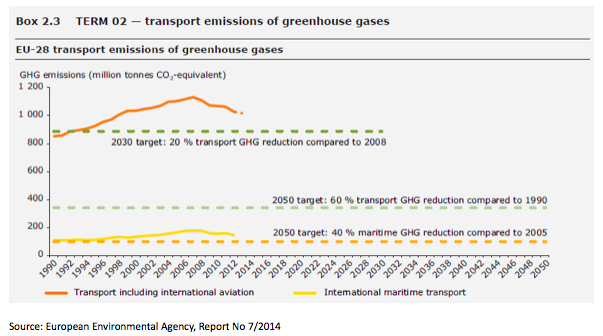
What Google tells us about the state of a paradigm shift in transport
The transport sector continues to be highly dependent on fossil fuels. Without a paradigm shift in transport, the energy transition is doomed to fail. An own-initiative report adopted yesterday by the European Parliament discusses the future of sustainable urban mobility, but falls short.
With all eyes currently turning to Paris to the COP21, the focus goes to the ‘energy transition’ that is needed to keep global warming below 2°C (or 1.5°C). The German version of that energy transition - Energiewende - receives nationally and internationally a lot of public interest. A search on Google may tell us how established the concept is: with 4.66 million hits probably very far. Yet without a paradigm shift in the European transport sector that today depends to 96% on fossil fuels, the energy transition has a massive problem. The fact that Verkehrswende (transition/ paradigm shift of the transport sector) generates 46,600 hits only on Google may be seen as a strong indicator that there is still a long way to go to mainstream the concept.
Against the background that 50 % of all trips in urban areas are shorter than 5 km and therefore could be easily made on foot, by bicycle or by public transport, the European Parliament yesterday adopted an own-initiative report on sustainable urban mobility. While the adoption in parallel with the COP21 may appear to be well-timed, the file, led by the Green rapporteur MEP Karima Delli, in fact saw considerable delays within the Parliaments Transport and Tourism Committee due to different views between the political groups.
Transport is the elephant in the room
The report is probably strongest in referring to the challenges the European (urban) transport sector is facing: by 2050, 82% of EU citizens will live in urban areas, adding to the pressure on the urban transport systems that already today sees a lot of congestion; 38 % of all fatalities occur in urban areas, 55 % on inter-urban roads; air pollution causes more than 400,000 premature deaths in the EU; transport is the only sector where CO2 emissions have increased since 1990 and its overall share in EU’s CO2 emissions grew to about 25 %. By 2050, transport has to decrease its GHG emissions by 60 % compared to 1990. The challenge is of such a magnitude that a technology-only approach is insufficient and must be complimented by ‘avoid’ and ‘shift’ policies. A study on a Global High Shift Cycling Scenario, commissioned by ECF and published in November 2015, concluded that globally 10 % of urban transport emissions could be avoided by 2050 if cycling was prioritised.
A Verkehrwende light
But the report is rather weak in developing a vision for urban mobility. In ECF’s view the objective of achieving the ambitious CO2 emission reduction targets in the transport sector will not be met without a paradigm shift, i.e. a massive modal shift from individual motorized transport to walking, cycling and public transport. And there will not be a modal shift without ambitious modal shift targets. Does the European Parliament own-initiative report on urban mobility rise to the challenge? Unfortunately not. The gap between what the Green rapporteur wanted and where she could find support by a parliamentary majority is wide. In the ‘Explanatory statement’ written by Delli she had claimed: “A different type of mobility is not only possible but essential in our congested urban and peri-urban areas. The aim is to rethink the way in which we move around in towns and cities, looking at both passenger and goods transport. […]To this end, the rapporteur proposes a target of doubling cycling rates in urban areas by 2025, and doubling the public transport network and use of public transport by 2030.”
While the final report calls several times for a modal shift both in passenger and goods transport, it shies away of setting any objectives. Instead it “encourages the Member States to promote, where appropriate, the use of bicycles, including by setting ambitious targets for cycling rates by 2030 and to improve conditions for walking and cycling.” (27). As for public transport, it stops at saying that it “calls on the Member States, […], to promote public transport with the view to increasing its use by 2030 (21).
On the have-side the report confirms the objectives of the 2011 Transport White Paper of the European Commission of halving ‘conventionally-fueled’ cars in urban transport by 2030 and of phasing them out in cities by 2050.
Instruments
Many suggestions to introduce instruments in order to create more sustainable urban mobility patterns are included in the report. Sustainable Urban Mobility Plans, behavioural change campaigns (‘EU Car-Free Sunday’, ‘EU Bicycle Day’), parking management, ITS, multi-modality, speed management, road charging… All good and fine. But again, the rapporteur initially intended to go much further than her fellow MEPs were willing to concede. For example, Delli proposed that “50 % of Eurovignette revenue be dedicated to improving urban mobility and that 75 % of urban tolls be used for developing and maintaining urban transport infrastructure” (See ‘Explanatory Statement’] whereas the final report “Recalls the 'use of revenues’ principle with regard to road charging, and calls, where appropriate, for a proportion of revenue from the use of road infrastructure (road charging and/or Eurovignette) to be dedicated to improving sustainable urban mobility”. (48) While e-mobility solutions usually draw a lot of attention in EU public affairs, the report basically limits itself by recalling Directive 2014/94/EU on the deployment of alternative fuels.
Conclusion
A transition of the energy sector is crucial for limiting global warming to below 2°C (or 1.5°C). Yet this transition will be doomed to fail without a paradigm shift in the transport sector, which with its growing CO2 emissions since 1990 has increasingly become the elephant in the room. The European Parliament own-initiative report on urban mobility that was adopted yesterday includes interesting elements in the discussion on how to realise that paradigm shift but overall falls short in developing a vision that prioritises walking, cycling and public transport over private car use. Verkehrswende has to become a concept as established as Energiewende. The future number of Google hits may be the indicator whether we are well on track.
Sources
European Parliament own-initiative report on sustainable urban mobility (2014/2242(INI)) http://www.europarl.europa.eu/sides/getDoc.do?type=REPORT&mode=XML&reference=A8-2015-0319&language=EN
 ABOUT THE AUTHOR Fabian Küster is a Senior Policy Officer at the European Cyclists’ Federation. He has previously worked in Brussels for a German Member of European Parliament and the German Embassy. He has wealth of experience in and around the EU institutions, and is an expert in the EU policy field of bicycles.
ABOUT THE AUTHOR Fabian Küster is a Senior Policy Officer at the European Cyclists’ Federation. He has previously worked in Brussels for a German Member of European Parliament and the German Embassy. He has wealth of experience in and around the EU institutions, and is an expert in the EU policy field of bicycles.
Regions:
Topics:
- Log in to post comments
Contact the author
Recent news!
Upcoming events
Contact Us
Avenue des Arts, 7-8
Postal address: Rue de la Charité, 22
1210 Brussels, Belgium










